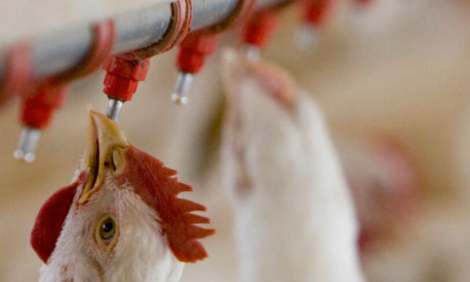



Ammonia reduction strategies for the pig & poultry sectors
Ammonia emissions from livestock present major challenges to the Northern Ireland agricultural industry.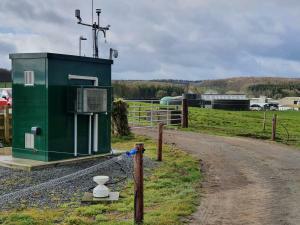

Funded by the Department of Agriculture, Environment and Rural Affairs (DAERA), the Agri-Food and Biosciences Institute (AFBI) is currently conducting a major programme of research and have released this series of articles to help stakeholders understand the issue and adopt solutions to reduce emissions.
Ammonia levels in the air are high in NI. These high levels can have wide-ranging negative environmental effects on sensitive habitats, human health and climate change. International targets have been set for the reduction of ammonia emissions, and the UK must achieve a reduction of 16% by 2030, in comparison to 2005 levels.
This article is the sixth in a series of articles from AFBI looking at the ammonia issue. In a previous article, the impact of a suite of ammonia abatement strategies adopted province-wide was shown to reduce ammonia emissions across NI by 25%. Last week’s article demonstrated that the adoption of proven ammonia reduction technologies, many of them with a low cost, can reduce emissions on typical dairy farms by over 43% and on typical beef farms by 34-42%.
As part of the same research programme, AFBI, working in collaboration with Rothamsted Research, have also been modelling ammonia emissions for typical Northern Ireland pig and poultry enterprises using the UK inventory model (NARSES). A number of proven and practical ammonia reduction measures have been applied to these baseline scenarios to evaluate the overall effect on the ammonia emissions from typical pig and poultry farms to demonstrate the reductions achievable on individual farms.
Pig System Scenarios
The two systems investigated here generally represent a large proportion of NI pig producers. These are 1) Sows and litter (to 40 kg) and 2) Finishing pigs (40 to 115 kg). Table 1 outlines the key parameters adopted as a ‘baseline’ for each of these systems.

Table 1. Parameters modelled for the baseline pig systemsAmmonia Reduction Strategies
Various ammonia reduction strategies were applied to both pig systems to generate ‘mitigation scenarios’. These included:
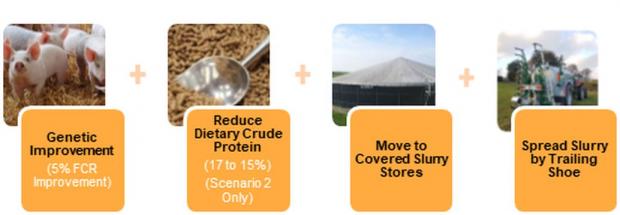
A fifth measure, pH adjustment of slurry in house (acidification), was applied to a duplicate of scenario 2.
Results
As shown in Figure 1, in the sows and litter scenario (1) total ammonia emission are reduced by 45%. The majority of these reductions are achieved in housing due to the modelled genetic improvement of the animal and the frequent removal of slurry to a covered outdoor store.
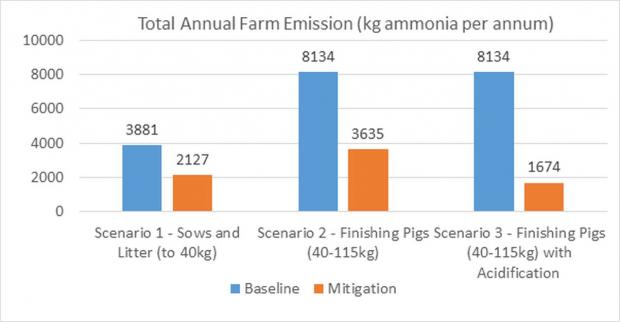
Figure 1. Total annual farm emission comparisons between pig scenario baselines and mitigations
A move to covered slurry stores achieves proportionally higher emission reductions in the pig sector than in the cattle sector due to the higher ammoniacal nitrogen content of pig slurry compared with cattle slurry, and the fact that pig slurry does not crust as readily as cattle slurry. Crusting creates a natural barrier and helps to reduce some of the ammonia emissions from slurry storage. Finally, land spreading emissions are reduced by approximately 60% with the move from splash plate to trailing shoe.
In the finishing pig scenario (2) a total ammonia reduction of 55% is achieved with the additional reduction above the previous scenario largely due to the reduction in the dietary crude protein (CP) to an optimal level. When an pH adjustment to slurry in-house (acidification) was added to this scenario (3) total farm ammonia was reduced by 79%. This is a very significant additional reduction, however the effects on soil health of long-term application of pH adjusted (acidified) slurry to land requires further research.
Poultry System Scenarios
A range of typical NI poultry systems were modelled, but the two being shown here represent 1) a standard broiler system and 2) a multi-tier free-range layer system. Table 2 outlines the key parameters used in each of the system as a ‘baseline’.

Table 2. Parameters modelled for the baseline poultry systems.
Ammonia Reduction Strategies
Three ammonia reduction measures were applied to each poultry system. These included:
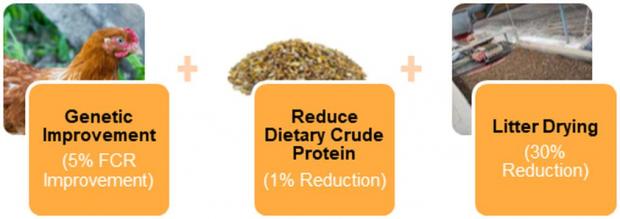
Results
Both scenarios achieved a 24% reduction in total ammonia emissions when the abatement measures were applied (Figure 2). The majority of reductions are achieved in housing, due to the modelled genetic improvement of the birds, the optimised CP diet and increased litter dry matter. However, these measures also reduce emissions at land spreading as lower nitrogen excretion leads to manure with a lower ammoniacal nitrogen content.
Manure land spreading emissions are a significant proportion of total emissions from a poultry system (as assumed here). However, in Northern Ireland, a large proportion of poultry manure is exported off-farm, so land spreading emissions may not be a component of the local system. If we omit land spreading emissions from the calculations, ammonia emission reductions of 35% are achievable across both scenarios.
Ammonia reductions during poultry litter land spreading to grassland are inherently difficult to achieve. Incorporation of poultry manure into tilled land within 24 h of application will give significant emission reductions over broadcast spreading on grassland, but this was not modelled on this occasion.
Another reduction option would be to spread only under favourable weather conditions, i.e. cool temperatures, or to treat litter in house or storage with alum, which has gained popularity in the US and can achieve emission reductions of up to 70% through Acidification. However, similar to the acidification of pig slurry, the effects on soil health of long-term application of acidified manure to land requires further research.
Air scrubbers also offer significant emission reduction potential (up to 90% reduction of housing emissions) for both pig and poultry facilities. But this measure was not modelled as it is seen as a relatively expensive ‘end of pipe’ solution. Scrubbers are most effective in mechanically ventilated accommodation and not as effective in free-range systems.
Overall, significant reductions in ammonia emissions are achievable across the pig and poultry scenarios modelled, using existing and proven ammonia reduction strategies which are technically feasible and could be adopted within a 5-10 year timeframe.
Genetic improvement is something that will continue to develop through selecting for feed efficiency. Optimised crude protein diets are a cost-effective method to reduce nitrogen excretion and subsequently ammonia emissions. Changes to manure management, such as covering slurry stores, drying litter and spreading slurry by trailing shoe will require more significant capital investment on farms, but are important if significant reductions in emissions from the sectors are to be made.








